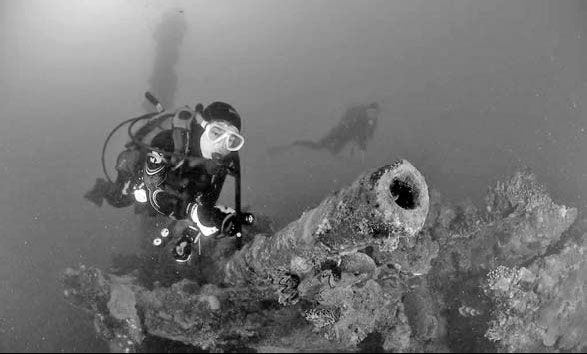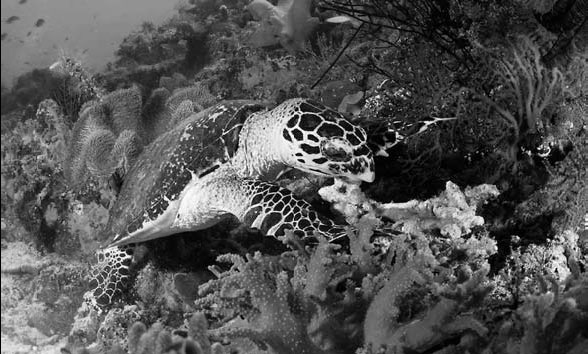Oceans come into focus
Updated: 2013-04-24 05:32
By Shi Yingying in Shanghai (China Daily)
|
|||||||||||
|
A diver explores a sunken wreck of World War II in the Republic of Palau. Photos by Yao Yi / For China Daily |
|
A sea turtle feeds in the ocean of Raja Ampat in Indonesia's West Papua province. |
While an increasing number of Chinese start to don a wetsuit and plunge into the depths of the ocean, their wish to record images of crystalline seas, magnificent coral reefs or rainbows of tropical fish has driven them to pick up cameras and become underwater photographer.
And they have discovered more than just the beauty they have desired.
"It's the magic of underwater photography that drives scuba divers to pick up the camera and makes photographers want to learn how to dive," says Cao Feng, 48, an amateur photographer.
The Shanghai native spent eight years photographing dry land before learning how to dive in 2011 to take photographs. "Now I can go as deep as 40 meters and I have already received my certificate for open-water diving," says Cao, explaining that there are deep-dive diplomas, dry-suit certificates, testimonials for wreck diving and citations for underwater photography.
Once a keen photographer of birds, Cao says an underwater photo exhibition shifted his view from high in the sky to the depths of the ocean.
"The biggest difference (between shooting on land and underwater) is the light - you will easily think about choosing the camera with high sensitivity or adjusting the aperture if there isn't enough light when taking photos on land, but it's a completely different story to shoot under water - white (objects) appear bluish and red (objects) appear dark or even black as sunlight is absorbed as depth increases," says Cao, explaining that even to the naked eye, everything underwater is blue or green in color. He says the solution lies in underwater photographic equipment.
"No photographer on the ground needs to learn how to solve the problem of buoyancy while talking a photo, but it's a must for anybody underwater," he says, adding that apart from wearing weighting belts made of lead and adjusting the amount of air in the buoyancy control device, one also needs to control breathing when diving.
But there are more than techniques to learn.
The underwater ecology, which is usually unseen by the normal, has become an issue distinct to Cao's alike.
A believer in "taking only photos and leaving only bubbles", Shanghai's Apple store manager Yao Yi has spent almost all of his holidays for the past nine years diving and taking underwater photos.
"My friend from the Chinese Academy of Sciences' Institute of Oceanology showed me photos of coral reefs they took in Xisha Islands' underwater areas - it's lifeless," says Yao, explaining coral reefs are "rainforests of the sea" and provide homes for many marine species including fish, worms, sponges and mollusks.
"If the coral situation isn't good, you wouldn't expect a fascinating underwater world packed with marine animals," he says.
Yao adds it has become an unwritten rule for divers to protect the marine ecological environment, and that diving and underwater photography do not cause as much damage to the oceans' ecosystem as smuggling coral, over-fishing and illegal fishing such as electrocution and poisoning.
"The over-exploitation of marine resources, however, is a global issue," Yao continues. "I remember the first time I went to dive at Malaysia's legendary Barracuda Point in 2006, thousands of barracudas were circling around to make a powerful image, like a storm, it was impossible to miss. But when I returned to the island of Sipadan in 2009, you could barely call it a 'storm', and you needed good luck to see the school of barracuda fish."
While many amateur underwater photographers have tried to avoid such less-undesirable water area, Wu Lixin, a photojournalist with Chinese National Geographic Magazine, has shifted his focus especially to these areas.
Wu has depicted some of the damage suffered by marine life in his photos. Muddy water, wild aquatic plants tainted with foreign substances, marine animals struggling to escape from fishing nets and fish gasping for their last breath in a dry river bed - Wu's photos dazzled the audience not only with images of the fantastic underwater world but also drew people's attention to marine environmental protection.
shiyingying@chinadaily.com.cn
(China Daily 04/24/2013 page20)
Today's Top News
China thanks countries
for quake relief aid
China, Europe need one another
Hungary official talks about youth exchange with China
Beijing protests Diaoyu incident
China's 2nd aircraft carrier will be 'larger'
H7N9 flu virus origins revealed
Beijing, Paris should 'work together'
Spanish party seeks ties with CPC
Hot Topics
Lunar probe , China growth forecasts, Emission rules get tougher, China seen through 'colored lens', International board,
Editor's Picks

|

|

|

|

|

|







